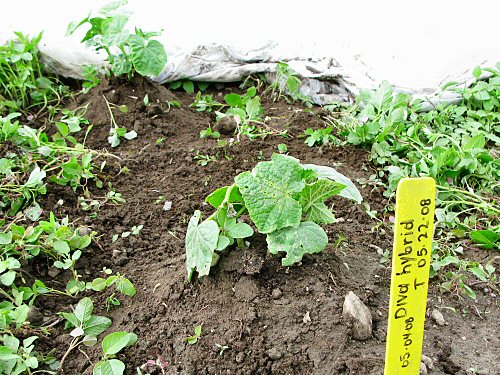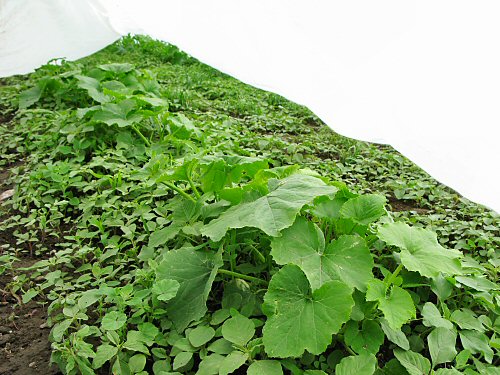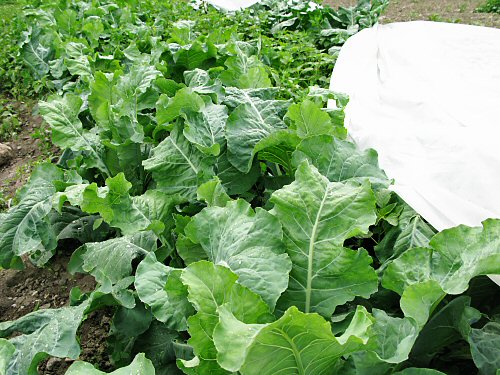Three weeks ago, it was floating row cover everywhere. So, what was it worth? Today, I checked things out. Overall, growth has been startlingly slow, due to the lack of sun. This is really noticeable in the summer squash (above), which could be huge at this point, but…aren’t. Under cover, these zucchini (I didn’t check the variety) are doing fine, no cucumber beetle damage, but of course, weeds are doing fine as well: unmolested under there, pigweed runs rampant. I’ll take the cover off here in another week or so, and then there’ll be a whole lotta weeding to do… I removed the cover from the first beds of cauliflower (Snow Crown) and broccoli (below), they’re big enough to take a little flea beetle munching. The leaves have shaded out much of the potential weed action in the beds, but you can see a nice collection in the path (top center, where the row cover ends). The plants look untouched, although the flea beetles managed to get under and at the kale and collards, (they’re out of sight just to the left)—I left them covered, back in a week. If there’s any doubt about what the FBs will do, just check the radishes, which grow MUCH faster than these guys and can survive the damage…
Back with the cucurbits, the cucumbers are the most noticeably slow: after a month, they’re hardly bigger than the transplants they started as (hope it’s all going into the roots!)… I’ve cleared away the weeds between a couple of the plants, beetle damage is minimal (they tend to get in at the ends of rows, where the cover can get blown up by the wind), but there are weeds everywhere. Cover goes back on here for a while. Weird stunting weather and floating row cover: not the most peaceful and inspiring natural garden combo, but it should all straighten out in a bit… ;)







just found your blog — it’s fabulous! although i’m not sure your farm is truly tiny at this point. 2 acres by hand sounds like a giant farm to me!
we cultivate five acres, but we use a couple tractors to do so. trade offs.
anyhow, happy farming!
your plants look good under the row cover better to have a few weeds than cucumber beetles ruining the plants…..pigweeds are an indicator of fertile soil.
That pigweed is also known as amaranth. When small it is sometimes included in salad green mixes. It gets tough and requires cooking to be palatable after it gets a bit bigger. Hint. Also it’s seed is quite high in protein and I am growing some this year as chicken feed. Bigger hint.
Rick
Do you leave the covers off the broccoli and cauliflower at this point? Do you not get cabbage maggots in them, or are they near enough to maturity? I have always had to keep the covers on to get decent broccoli or cauliflower.
Chris
cathy: Fertile soil is good! I always like the upside to things… ;)
Katie (Oakhill Organics): Yeah, especially on a day like today, just coming in from a thorough weed tour, adding up what needs to be done first, and how many hours and hours each bit will take, it doesn’t feel so tiny!! Your veggies look great! When I see farms and particularly market gardens like yours, I wonder a little about the soundness of what I’m doing. By “like yours,” I mean new small farms that’re striving for sustainability, crop diversity, the whole thing, but at a bit larger, more economically practical size. And that gets into tractors, which can be…electric tractors, but bigger machinery still. I have an ongoing debate with Bob here (old time farmer), running from Year 1, about how I should plant long rows (400′ instead of in 50′ beds), get an old tractor, and use it to scuffle between rows. This would knock off maybe 50% of the year’s labor for relatively very little investment. But I seem obsessed with this do-it-mostly-by-hand thing… I dunno… :)
Rick: Yes, the irony that is pigweed is not lost on me. The many flavors of amaranth. I’m growing some grain amaranth again this year, just a little for fun, and I’ve just been weeding pigweed from right beside a couple of decorative varieties of amaranth that I’m growing in the cut flower section. Last year, I tried a bed of vegetable amaranth for adding to salad mix. And they all look pretty much the same when they get started, just different colors and shades… Oh, well, I guess I could get rid of my weed problem in an instant by deciding it’s actually a crop. But I don’t think I’d have too many takers at the market…
Chris: Yep, the covers stay off. LUCKILY, I haven’t run into cabbage maggots, just the FBs…!
Oh! I just commented on your pigweed “problem” last year – so glad you’re growing grain amaranth this year! I’ll await the results with baited breathe! And then, yes, you’ll want to weed out the lamb’s quarters because it will cross-pollinate very easily. And like I mentioned in the other comment – farmer’s market. Toronto. $5 for a small bunch. And it wasn’t vegetable amaranth, it was pigweed, the same that grows in my backyard. You know those Torontonians – they’ll buy anything if it’s hip ;-)
Hello there, i just believed iwould report and let you know your blog layout is definitely messed up about the K-Melon web browser. Anyways maintain up the great operate.
hey nice looking caulis, I tend to only use cover in late summer, phacelia is used every 8 to 10 rows as a biological barrier sometimes with buckwheat and red clover depending on the drop and the dominate insect….. are you guys doing anything like that in the states we/I don’t have the problems you do with beetles mostly cabbage white and their caterpillars